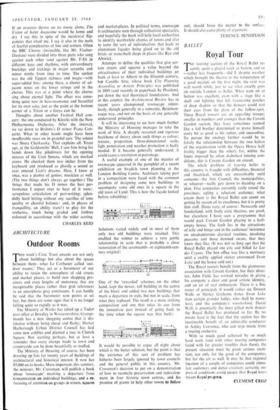ARCHITECTURE
Outdoor Rooms
THIS week's Civic Trust awards are not only about buildings but also about the spaces between them—what Le Corbusier called 'out- door rooms.' They act as a barometer of our ability to retain the atmosphere of old streets and market places, to build new shopping pre- cincts and even lengths of motorway that are recognisable places rather than grid references in an amorphous grey continuum. It can hardly be said that the barometer now points at set fair, but there are some signs that it is no longer falling quite so rapidly as it was.
The Ministry of Works has tidied up a Tudor post office at Bewdley in Worcestershire; Grange- mouth has a new shopping centre that is dis- tinctive without being cheap and flashy; Market Harborough Urban District Council has laid some new cobbles and planted a tree in Church Square. Not startling perhaps, but at least a reminder that every change made to town and countryside can be done beautifully or muffed.
The Ministry of Housing, of course, has been drawing up lists for twenty years of buildings of architectural and historical interest. It now has 85,000 on its books. More important, this summer, the minister, Mr. Crossman, will publish a book about `townscape' marking a departure from concentration on individual buildings, and a re- focusing of attention on groups in streets, squares
and market-places. In political terms, townscape is architecture seen through collectivist spectacles, and hopefully the book will help local authorities to identify worthwhile chunks of towns and also to tame the sort of individualism that leads to aluminium facades being glued on to the old brick- or stone-built shops in places like Rye and Alnwick.
Attempts to define the qualities that give cer- tain streets and squares a value beyond the attractiveness of their individual buildings go back at least to Alberti in the fifteenth century, but Camillo Sitte, whose book City Planning According to Artistic Principles was published in 1889 (and recently in paperback by Phaidon), put down the real theoretical foundations. And in this country the Architectural Review has in recent years championed townscape relent- lessly, though generally in a romantic, Betjeman- esque way, and not on the basis of any generally understood principles.
It will be interesting to see how much further the Ministry of Housing manages to take the work of Sitte. A sharply reasoned and rigorous backbone of theory about such things as colour, texture, proportion, three-dimensional scale, light penetration and weather protection is badly needed. If it became generally understood, it could cause a revolution in patronage.
A useful example of one of the niceties of townscape appeared in the pamphlet of a recent exhibition on Swedish town planning at the London Building Centre. Architects taking part in a competition were faced with the common problem of designing some new buildings to accompany some old ones in a square in the old town of Lund. This is how the facade looked before rebuilding: Solutions varied widely and in most of them only two old buildings were retained. This enabled the winner to achieve a very gentle relationship in scale that is probably a close restoration of the seventeenth- or eighteenth-cen- tury original : One of the 'rewarded' schemes, on the other hand, kept the newer, tall building in the centre of the block and added two new buildings that mark a departure in style, but not in scale, from what they replaced. The result is a more striking composition and one that takes its cue from the immediate past instead of going back to the time when the square was first built: It would be possible to argue all night about which is the better solution, but the point is that the existence of this sort of problem has hitherto been largely ignored by town councils and the general public in this country. Mr. Crossman's decision to put on a demonstration of how to reconcile preservation and redevelop- ment in four historic -town centres, and his promise of grants to help other towns to follow suit, should force the matter to the surfac,:. It should also cause plenty of argument.
TERENCE BENDIXSON


































 Previous page
Previous page